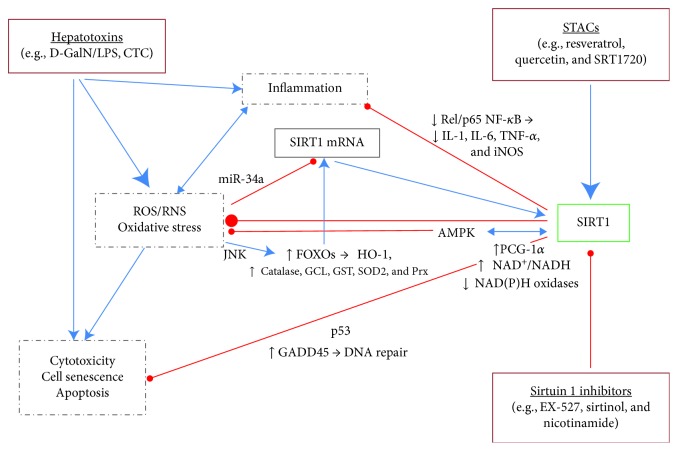Figure 4.
Effects of sirtuin 1-activating compounds (STACs) and inhibitors on chemically induced hepatotoxicity. Hepatotoxins, like D-GalN/LPS and CTC, induce the formation of ROS/RNS in hepatocytes leading to oxidative stress, inflammation, and cell death. SIRT1 is activated and inhibited by stress-responsive factors and plays a dynamic role in regulating cytoprotection and apoptosis depending on the dosing schedule. SIRT1 activation by STACs results to a decrease of cell death and an increase in stress adaptation of hepatocytes due to the activation (↑) or the inhibition (↓) of various signaling and antioxidant molecules (not all included). These hepatoprotective effects can be blocked by administration of SIRT1 inhibitors. Blue →: activation; red ─●: inhibition; AMPK: AMP-activated protein kinase; CTC: carbon tetrachloride; D-GalN: D-galactosamine; FOXOs: forkhead homeobox type O family including FoxO1, FoxO3, and FoxO4; GADD45: growth arrest and DNA damage-inducible protein; GCL: glutamate cysteine ligase; GST: glutathione transferase; HO-1: heme oxygenase-1; IL-1/6: interleukin-1/6; iNOS: inducible nitric oxide synthase; JNK: c-Jun N-terminal kinase; LPS: lipopolysaccharide; miR-34a: microRNA-34a; NAD+: nicotinamide adenine dinucleotide; p53: tumor suppressor protein p53; PGC-1α: peroxisome proliferator-activated receptor gamma coactivator 1 alpha; Prx: peroxiredoxins; RelA/p65/NF-κB: RelA/p65 subunit of nuclear factor kappa-B; ROS: reactive oxygen species; RNS: reactive nitrogen species; SIRT1: silent information regulator (two) 1 (sirtuin 1); SOD2: superoxide dismutase 2; TNF-α: tumor necrosis factor-alpha.

